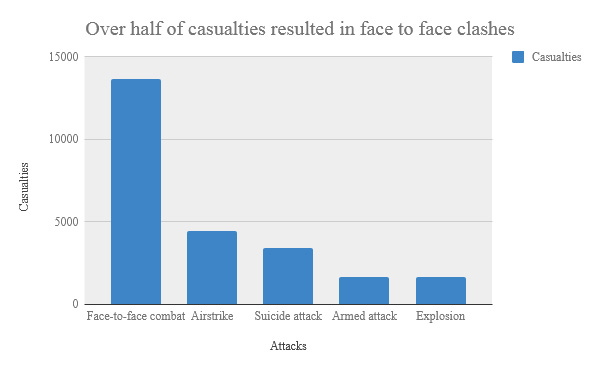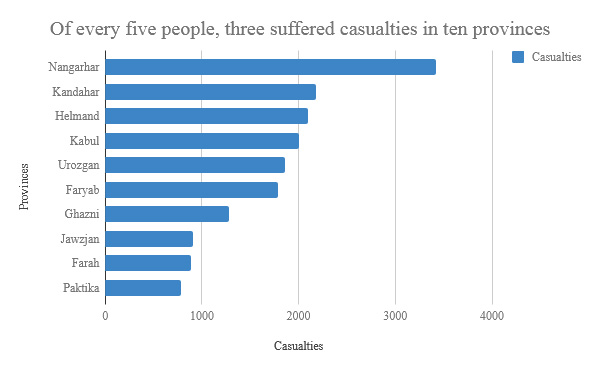PAN, January 14, 2018
2017 causalities: nearly 25,000 people killed, wounded in Afghanistan
Secondly, the number of casualties was high in airstrikes because these attacks were deadliest and there was more chance of collateral damage in airstrikes.
By Ahmad Shah Erfanyar
Sixty-eight people have been killed and injured in Afghanistan on average level daily in 2017 with more than one third of these casualties happened in May, July and August months.
According to Pajhwok Afghan News’s disseminated reports from different sources 14,600 people have been killed and 10,277 others injured in 2,050 various attacks last year.
From the total casualties 14 of every 25 people suffered losses in face to face clashes, four in airstrikes, three in suicide attacks, two each in targeted attack and bomb blasts.
In face to face clashes, security forces and militants (Daesh, Taliban) suffered most of casualties but last year there were reports of clashes between the Taliban and Daesh as well.
Zalmai Wardak, military affairs expert, said more face to face clashes had been taking place therefore more casualties inflicted in face to face firefight.
He added: “Conflicting sides had been involved in direct firefight and use light and heavy weapons against each other which resulted in the surge of loses.”
Secondly, the number of casualties was high in airstrikes because these attacks were deadliest and there was more chance of collateral damage in airstrikes.
In targeted attacks, roadside bombing and magnetic bomb explosions the number of casualties was lower because few people had been killed in injured in these attacks.

Most of the last year attacks accounted for 347 took place in Nangarhar, 184 in Faryab, 168 in Helmand, 140, in Kandahar, 100 in Farah, 104 in Ghazni, 96 in Uruzgan, 83 in Logar, 77 in Jawzjan, 72 in Paktika, 63 in Kabul and the remaining 616 attacks happened in 22 provinces.
The least attacks accounted for one took place in Panjshir, two in Bamyan while Pajhwok did not received any report of casualties from Daikundi province last year.
According to Zalmai Wardak, the number of attacks was up in Nangarhar province last year because besides the Taliban, Daesh was also active there.
He added Nangarhar and Helmand provinces shared border with Pakistan which another reason of growing attacks.
In addition, the growing of narcotics in Helmand was another reason of insecurity and lawlessness.
Sharing his views regarding Faryab, he said the province was of high importance for militants in the north, because from Faryab rebels could move to other provinces of the north as well.
He said besides the Taliban, Daesh had become more active with its insurgent activities in Faryab.

Zalmai said people living in Panshir, Bamyan and Daikundi provinces mostly belonged to one tribe and they have unity among themselves and decided not to allow anyone for insurgent activities.
Gen. Mohammad Radmnish, deputy spokesman of the Ministry of Defence, agreed that shared border with Pakistan, the growing of illicit crop had helped insurgency in Helmand and Nangarhar province. He added the government had conducted clearing operations against rebels there.
Casualties:
According to reports, last year most of the attacks 15 occurred on November 11, while most people accounted for 569 suffered casualties on June 26.
Security forces, militants and civilians are among the dead and injured people, but Pajhwok could not share separate and exact number dead and injured of each category because different sources shared different views.
Last year, most of the casualties occurred in Nangarhar, Kandahar, Helmand and Kabul provinces and the least number of casualties took place in Panshir, Bamyan, Samangan and Badghis provinces.
Militants have been fighting Afghan and foreign security forces in Afghanistan from the past 17-year.
The exact number of casualties before 2017 was not available, but in the past years there was let up in the fighting during winter season which resulted decline in casualties as well.
Pajhwok annual report showed that last year there was more fighting in spring and summer compared to fall and winter and the number of casualties was also high in spring and summer seasons compared to fall and winter.
Military affairs Expert Zalmai Wardak said during winter season the leaves of trees fell to the ground and rebels could not hide themselves thus there reduce their activities.
“Usually these rebels go to the provinces like Helmand, Kandahar, or Farah where the weather is warm during winter or cross the border into Pakistan for next year arms preparation.
Radmnish said rebels suffer from losses and shortage of equipment therefore there movement declines.
He, however, said security forces operation against rebels was underway in ten provinces of the country currently.
Stop killing of Afghans!
Attaullah, the resident of Maidan Wardak province Ibrahimkehl village, said: “Afghans were being killed under one or another name. I want armed groups and the government to stop fighting and reconcile like brothers.” He added one of his relative was injured while he was working in the agriculture land.
He asked the international community to help Afghanistan end the ongoing conflict and stop interference of countries in Afghanistan who had been fueling the current conflict to ensure their own interest.
Muharam Ali, the resident of Kabul’s Dasht-i-Barchi area who lost his farther in recent terrorist attack on Imam Zaman Mosque, said: “We want peace; we want the ongoing fighting and killing of Afghans.”
Characters Count: 6783
